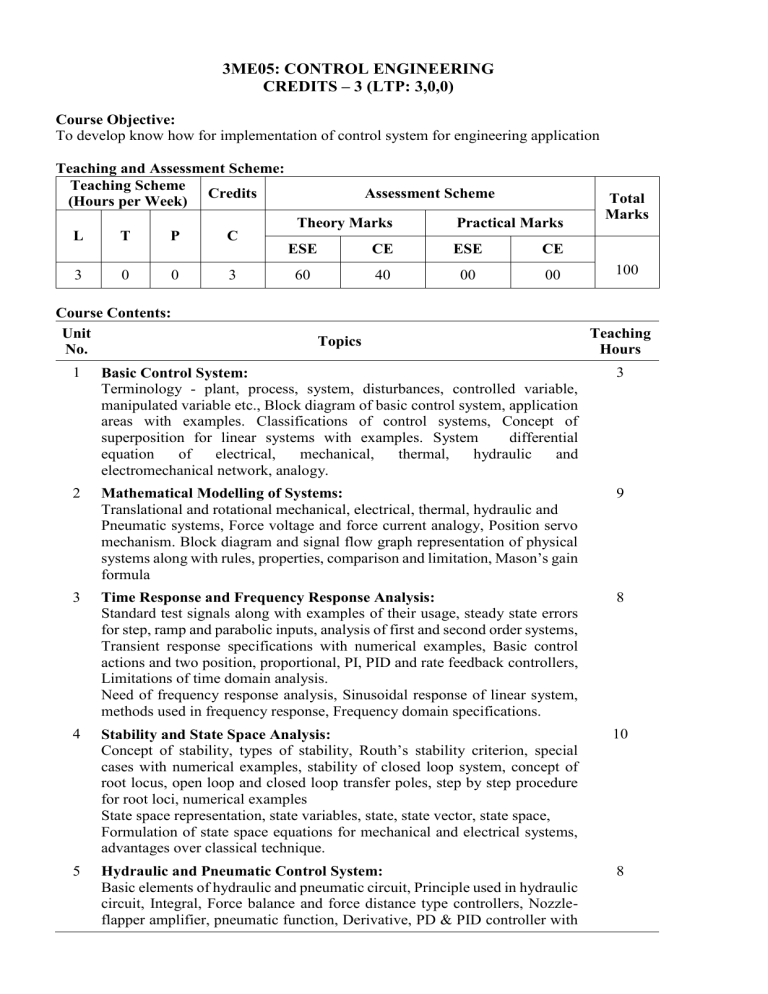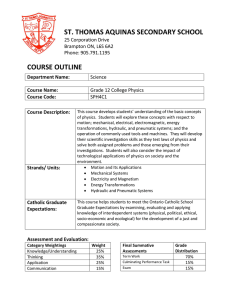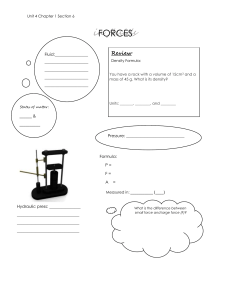
3ME05: CONTROL ENGINEERING CREDITS – 3 (LTP: 3,0,0) Course Objective: To develop know how for implementation of control system for engineering application Teaching and Assessment Scheme: Teaching Scheme Credits (Hours per Week) Assessment Scheme Theory Marks L 3 T 0 P 0 Course Contents: Unit No. Practical Marks Total Marks C 3 ESE CE ESE CE 60 40 00 00 Topics 100 Teaching Hours 1 Basic Control System: Terminology - plant, process, system, disturbances, controlled variable, manipulated variable etc., Block diagram of basic control system, application areas with examples. Classifications of control systems, Concept of superposition for linear systems with examples. System differential equation of electrical, mechanical, thermal, hydraulic and electromechanical network, analogy. 3 2 Mathematical Modelling of Systems: Translational and rotational mechanical, electrical, thermal, hydraulic and Pneumatic systems, Force voltage and force current analogy, Position servo mechanism. Block diagram and signal flow graph representation of physical systems along with rules, properties, comparison and limitation, Mason’s gain formula 9 3 Time Response and Frequency Response Analysis: Standard test signals along with examples of their usage, steady state errors for step, ramp and parabolic inputs, analysis of first and second order systems, Transient response specifications with numerical examples, Basic control actions and two position, proportional, PI, PID and rate feedback controllers, Limitations of time domain analysis. Need of frequency response analysis, Sinusoidal response of linear system, methods used in frequency response, Frequency domain specifications. 8 4 Stability and State Space Analysis: Concept of stability, types of stability, Routh’s stability criterion, special cases with numerical examples, stability of closed loop system, concept of root locus, open loop and closed loop transfer poles, step by step procedure for root loci, numerical examples State space representation, state variables, state, state vector, state space, Formulation of state space equations for mechanical and electrical systems, advantages over classical technique. 10 5 Hydraulic and Pneumatic Control System: Basic elements of hydraulic and pneumatic circuit, Principle used in hydraulic circuit, Integral, Force balance and force distance type controllers, Nozzleflapper amplifier, pneumatic function, Derivative, PD & PID controller with 8 Unit No. Teaching Hours Topics its transfer Comparison between hydraulic, pneumatic and electrical control system. 6 Introduction To Digital Control: Introduction of hardware & software, Basics of Arduino, Functional block diagram of Arduino, Functions of each pin of arduino, Arduino development board diagram (including different blocks): IDE, I/O functions, looping techniques, decision making techniques, Programming of an arduino, basic circuit for arduino, basic interfacing & i/o concept, interfacing LED, switch and seven segment LED & its code. Introduction to motion logic drive (Hardware & software), Programmable logic controller, Programming in motion logic drive, case studies. 4 Total 42 List of References: 1. Ogata K, “Modern Control Engineering”, Pearson Education 2. Nagrath &Gopal, “Control Systems Engineering” New Age International Publishers 3. Kuo, Benjamin, “Automatic Control System”, Prentice Hall 4. S K Bhattacharya, “Control Systems Engineering”, Pearson Education 5. Jeremy blum, “Exploring Arduino: Tools and Techniques for Engineering Wizardry”, Willey Publication Course Outcomes (COs): At the end of this course students will be able to … 1. Develop the mathematical model for engineering systems. 2. Develop the transfer function from block diagrams and signal flow graphs of linear systems. 3. Understand concept of time and frequency response analysis. 4. Use hydraulic and pneumatic concepts/components in control systems. 5. Evaluate stability conditions and steady state error. 6. Apply modern concepts of control in engineering systems.


